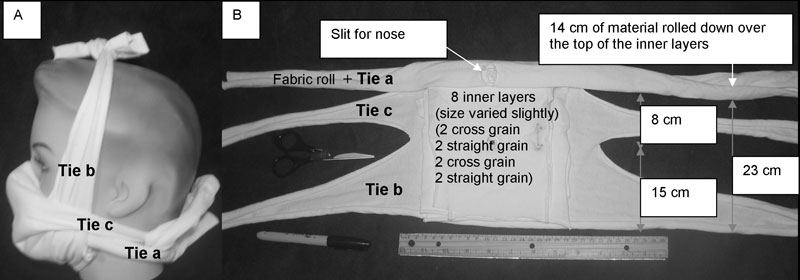Welcome to DU!
The truly grassroots left-of-center political community where regular people, not algorithms, drive the discussions and set the standards.
Join the community:
Create a free account
Support DU (and get rid of ads!):
Become a Star Member
Latest Breaking News
General Discussion
The DU Lounge
All Forums
Issue Forums
Culture Forums
Alliance Forums
Region Forums
Support Forums
Help & Search
General Discussion
Related: Editorials & Other Articles, Issue Forums, Alliance Forums, Region Forums"Simple Respiratory Mask" from Emerging Infectious Disease Journal, 2006
Keep in mind that relative to many aerosol materials, the coronavirus is very, very, very small - orders of magnitude smaller than many infectious agents.Like projects? Cooped up with nothing to do? Here's one way to spend time...

https://wwwnc.cdc.gov/eid/article/12/6/05-1468_article#tnF1
The World Health Organization recommends protective equipment including masks (if they not available, a cloth to cover the mouth is recommended) for persons who must handle dead or ill chickens in regions affected by H5N1 (5). Quality commercial masks are not always accessible, but anecdotal evidence has showed that handmade masks of cotton gauze were protective in military barracks and in healthcare workers during the Manchurian epidemic (6,7). A simple, locally made, washable mask may be a solution if commercial masks are not available. We describe the test results of 1 handmade, reusable, cotton mask.
For material, we choose heavyweight T-shirts similar to the 2-ply battle dress uniform T-shirts used for protective masks against ricin and saxitoxin in mouse experiments (8). Designs and T-shirts were initially screened with a short version of a qualitative Bitrex fit test (9) (Allegro Industries, Garden Grove, CA, USA). The best were tested by using a standard quantitative fit test, the Portacount Plus Respirator Fit Tester with N95-Companion (TSI, Shoreview, MN, USA) (10). Poor results from the initial quantitative fit testing on early prototypes resulted in the addition of 4 layers of material to the simplest mask design. This mask is referred to as the prototype mask (Figure).
A Hanes Heavyweight 100% preshrunk cotton T-shirt (made in Honduras) (http://www.hanesprintables.com/Globals/Faq.aspxExternal Link) was boiled for 10 minutes and air-dried to maximize shrinkage and sterilize the material in a manner available in developing countries. A scissor, marker, and ruler were used to cut out 1 outer layer (≈37 × 72 cm) and 8 inner layers (<18 cm2). The mask was assembled and fitted as shown in the Figure.
A fit factor is the number generated during quantitative fit testing by simulating workplace activities (a series of exercises, each 1 minute in duration). The Portacount Plus Respirator Fit Tester with N95-Companion used for the test is an ambient aerosol instrument that measures aerosol concentration outside and inside the prototype mask. The challenge agent used is the ambient microscopic dust and other aerosols that are present in the air.
InfoView thread info, including edit history
TrashPut this thread in your Trash Can (My DU » Trash Can)
BookmarkAdd this thread to your Bookmarks (My DU » Bookmarks)
1 replies, 916 views
ShareGet links to this post and/or share on social media
AlertAlert this post for a rule violation
PowersThere are no powers you can use on this post
EditCannot edit other people's posts
ReplyReply to this post
EditCannot edit other people's posts
Rec (13)
ReplyReply to this post
1 replies
 = new reply since forum marked as read
Highlight:
NoneDon't highlight anything
5 newestHighlight 5 most recent replies
= new reply since forum marked as read
Highlight:
NoneDon't highlight anything
5 newestHighlight 5 most recent replies
"Simple Respiratory Mask" from Emerging Infectious Disease Journal, 2006 (Original Post)
jberryhill
Mar 2020
OP
mitch96
(13,892 posts)1. Saw something similar in an old Radiology book
When I was a new tech I was in an old medical library. There was a ancient book on Radiology that had things needed and how to set up a radiology department from scratch..
The mask in your article was just about the same from this 1925 book..
"Radiology by Dr William Santee" Weird, eh?
m